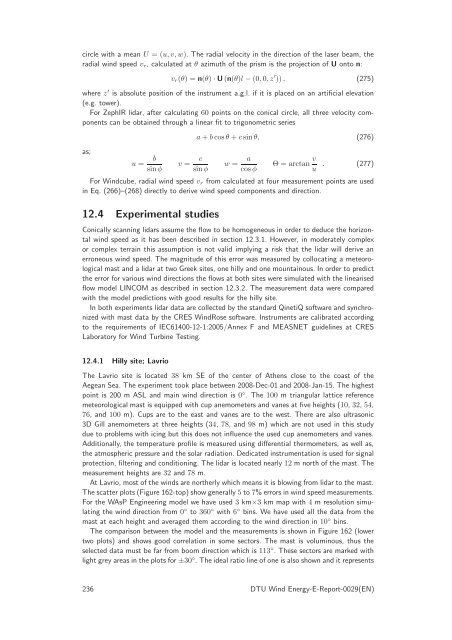Publishers version - DTU Orbit
Publishers version - DTU Orbit
Publishers version - DTU Orbit
You also want an ePaper? Increase the reach of your titles
YUMPU automatically turns print PDFs into web optimized ePapers that Google loves.
circle with a mean U = (u,v,w). The radial velocity in the direction of the laser beam, the<br />
radial wind speed vr, calculated at θ azimuth of the prism is the projection of U onto n:<br />
vr(θ) = n(θ)·U(n(θ)l −(0,0,z ′ )), (275)<br />
where z ′ is absolute position of the instrument a.g.l. if it is placed on an artificial elevation<br />
(e.g. tower).<br />
For ZephIR lidar, after calculating 60 points on the conical circle, all three velocity components<br />
can be obtained through a linear fit to trigonometric series<br />
as;<br />
u = b<br />
sinφ<br />
v = c<br />
sinφ<br />
a+bcosθ+csinθ, (276)<br />
w = a<br />
cosφ<br />
Θ = arctan v<br />
u<br />
. (277)<br />
For Windcube, radial wind speed vr from calculated at four measurement points are used<br />
in Eq. (266)–(268) directly to derive wind speed components and direction.<br />
12.4 Experimental studies<br />
Conically scanning lidars assume the flow to be homogeneous in order to deduce the horizontal<br />
wind speed as it has been described in section 12.3.1. However, in moderately complex<br />
or complex terrain this assumption is not valid implying a risk that the lidar will derive an<br />
erroneous wind speed. The magnitude of this error was measured by collocating a meteorological<br />
mast and a lidar at two Greek sites, one hilly and one mountainous. In order to predict<br />
the error for various wind directions the flows at both sites were simulated with the linearised<br />
flow model LINCOM as described in section 12.3.2. The measurement data were compared<br />
with the model predictions with good results for the hilly site.<br />
In both experiments lidar data are collected by the standard QinetiQ software and synchronized<br />
with mast data by the CRES WindRose software. Instruments are calibrated according<br />
to the requirements of IEC61400-12-1:2005/Annex F and MEASNET guidelines at CRES<br />
Laboratory for Wind Turbine Testing.<br />
12.4.1 Hilly site; Lavrio<br />
The Lavrio site is located 38 km SE of the center of Athens close to the coast of the<br />
Aegean Sea. The experiment took place between 2008-Dec-01and 2008-Jan-15. The highest<br />
point is 200 m ASL and main wind direction is 0 ◦ . The 100 m triangular lattice reference<br />
meteorological mast is equipped with cup anemometers and vanes at five heights (10, 32, 54,<br />
76, and 100 m). Cups are to the east and vanes are to the west. There are also ultrasonic<br />
3D Gill anemometers at three heights (34, 78, and 98 m) which are not used in this study<br />
due to problems with icing but this does not influence the used cup anemometers and vanes.<br />
Additionally, the temperature profile is measured using differential thermometers, as well as,<br />
the atmospheric pressure and the solar radiation. Dedicated instrumentation is used for signal<br />
protection, filtering and conditioning. The lidar is located nearly 12 m north of the mast. The<br />
measurement heights are 32 and 78 m.<br />
At Lavrio, most of the winds are northerly which means it is blowingfrom lidar to the mast.<br />
Thescatterplots(Figure 162-top)showgenerally5to 7%errors inwindspeed measurements.<br />
For the WAsP Engineering model we have used 3 km×3 km map with 4 m resolution simulating<br />
the wind direction from 0 ◦ to 360 ◦ with 6 ◦ bins. We have used all the data from the<br />
mast at each height and averaged them according to the wind direction in 10 ◦ bins.<br />
The comparison between the model and the measurements is shown in Figure 162 (lower<br />
two plots) and shows good correlation in some sectors. The mast is voluminous, thus the<br />
selected data must be far from boom direction which is 113 ◦ . These sectors are marked with<br />
lightgrey areasin the plotsfor ±30 ◦ . Theideal ratioline ofone is alsoshownand it represents<br />
236 <strong>DTU</strong> Wind Energy-E-Report-0029(EN)

















